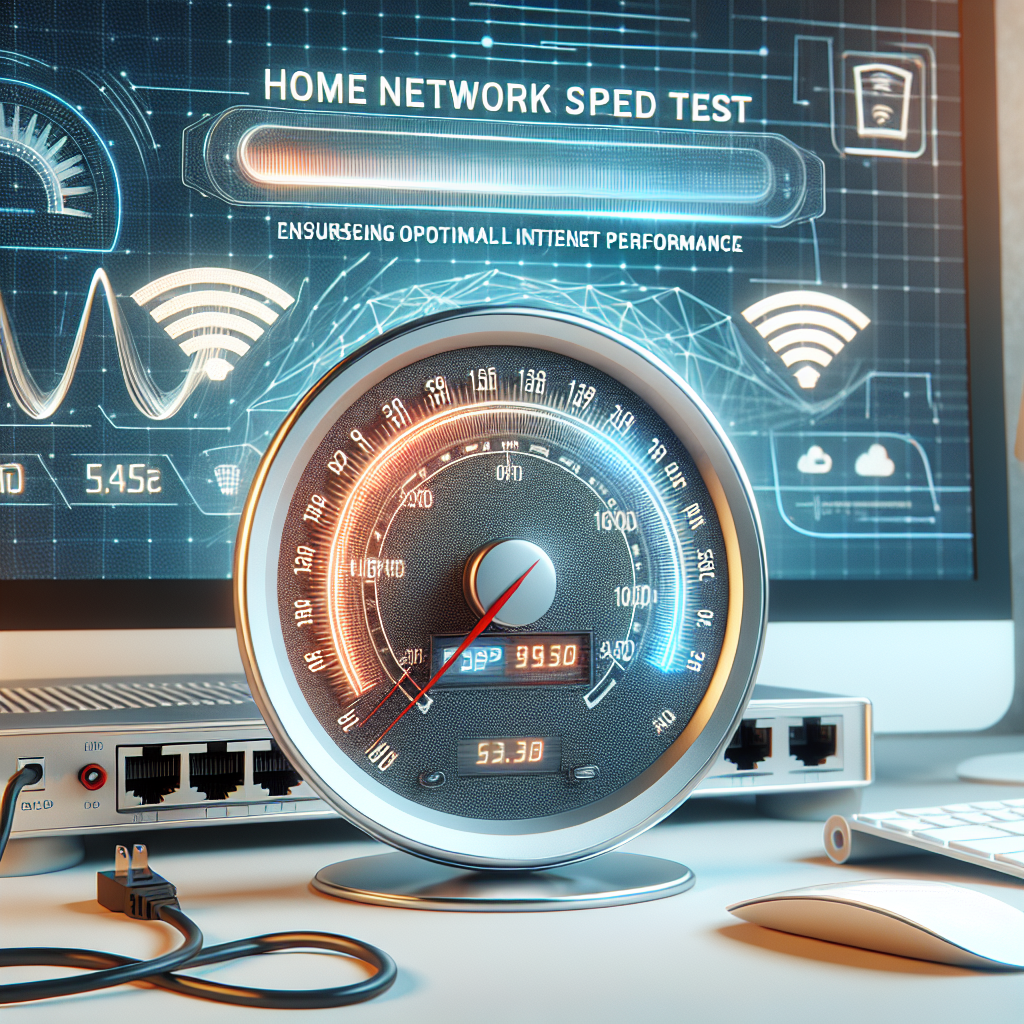Welcome to the world of home network speed testing, where you can ensure optimal internet performance right at your fingertips. In this fast-paced digital age, having a reliable and high-speed internet connection is essential for seamless browsing, streaming, and gaming experiences. With a home network speed test, you can easily evaluate the speed and performance of your internet connection, helping you identify any potential issues that may be slowing down your online activities. Say goodbye to frustrating lags and buffering with our simple yet effective tool that will ensure you get the most out of your internet service.
Understanding Home Network Speed

What is Home Network Speed?
Understanding Home Network Speed
- Definition of home network speed
Home network speed refers to the rate at which data is transmitted between devices within a household network. It is measured in megabits per second (Mbps) and determines how quickly information can be sent and received over the internet. Home network speed is influenced by factors such as the type of internet connection, the quality of the router, and the number of devices connected to the network. - Importance of home network speed for internet performance
The home network speed plays a crucial role in ensuring optimal internet performance. A fast and reliable network speed means smoother browsing, faster downloads, and better streaming quality. Slow network speeds can lead to buffering issues, dropped connections, and overall poor user experience. Therefore, testing and optimizing home network speed is essential for maximizing the efficiency of internet usage in a household.
Factors Affecting Home Network Speed
- Bandwidth availability
- Bandwidth refers to the maximum rate at which data can be transferred over a network connection.
- Insufficient bandwidth can lead to slow internet speeds and buffering while streaming content.
- Bandwidth availability may vary depending on the internet service plan chosen by the user.
- Type of connection (DSL, cable, fiber, etc.)
- The type of connection used in a home network significantly impacts internet speed.
- DSL (Digital Subscriber Line) connections typically offer slower speeds compared to cable or fiber optic connections.
- Fiber optic connections provide the fastest speeds due to the use of light signals for data transmission.
- Network congestion
- Network congestion occurs when there is high traffic on a network, leading to slower speeds for all connected devices.
- Congestion can be caused by multiple devices simultaneously using the network or peak usage times in the area.
- To alleviate network congestion, users can consider upgrading their internet plan or implementing quality of service (QoS) settings on their router.
Why Conduct a Home Network Speed Test
Identifying Internet Speed Issues
Why Conduct a Home Network Speed Test
- Recognizing slow connection speeds
- Conducting a home network speed test can reveal if the internet speed being received matches what was promised by the service provider. Discrepancies between the advertised speed and the actual speed experienced by users may indicate underlying issues affecting the connection.
- Slow loading times for websites, buffering during streaming, or delays in online gaming can all be signs of inadequate internet speeds. By running a speed test, users can confirm if their connection is the culprit behind these performance issues.
- Pinpointing areas for improvement
- Home network speed tests can help pinpoint specific areas within the network where speed issues may be occurring. Whether it’s a problem with the modem, router, or the devices themselves, conducting regular speed tests can assist in isolating the source of the problem.
- Identifying where the bottleneck lies in the network can guide users in making targeted improvements, such as upgrading hardware, adjusting settings, or relocating devices to optimize internet performance.
Ensuring Consistent Performance
Maintaining optimal internet speed for various activities is crucial in today’s digital age where individuals rely heavily on a stable connection for work, entertainment, and communication. Conducting regular home network speed tests is essential to ensure that the internet performance meets the demands of these activities. By consistently monitoring the speed of your home network, you can proactively identify any issues that may be causing slowdowns or disruptions in connectivity.
Enhancing user experience with reliable connectivity is another key reason to conduct home network speed tests. In a world where streaming services, online gaming, video conferences, and cloud-based applications are part of daily life, a slow or unreliable internet connection can lead to frustration and decreased productivity. By running speed tests and addressing any issues promptly, you can create a seamless online experience for all users in your household.

How to Perform a Home Network Speed Test
Choosing the Right Speed Test Tool
How to Perform a Home Network Speed Test
When it comes to assessing the speed of your home network, selecting the appropriate speed test tool is crucial to obtaining accurate results. Here is a detailed look at the factors to consider when choosing the right speed test tool:
- Overview of popular speed test websites
- Ookla Speedtest: One of the most widely used speed test tools, Ookla Speedtest offers a user-friendly interface and provides detailed information on both download and upload speeds, as well as latency.
- Fast.com: Developed by Netflix, Fast.com is a simple speed test tool that focuses solely on download speed, making it ideal for quickly checking how well your connection can stream content.
- Google Speed Test: Google offers its own speed test tool, which provides a basic assessment of your internet speed directly from the search results page, eliminating the need to visit a separate website.
- Factors to consider when selecting a speed test tool
- Accuracy: Look for speed test tools that are known for their reliability and accuracy in measuring internet speeds. Tools like Ookla Speedtest are popular choices due to their reputation for providing precise results.
- Compatibility: Ensure that the speed test tool you choose is compatible with the devices and browsers you plan to use for the test. Some tools may perform differently on various platforms.
- Additional Features: Consider whether you require additional features such as the ability to test connection stability, packet loss, or server selection options. Different speed test tools offer varying levels of detail in their reports.
- Ease of Use: Opt for a speed test tool that is easy to navigate and understand, especially if you are not familiar with technical jargon related to internet speeds. A user-friendly interface can make the testing process simpler and more efficient.
By carefully evaluating these factors, you can select a speed test tool that best suits your needs and helps you accurately assess the performance of your home network.
Conducting the Speed Test
Performing a home network speed test is a crucial step in ensuring optimal internet performance. By conducting regular speed tests, you can identify potential issues affecting your network’s speed and address them promptly. Here is a step-by-step guide to running an effective home network speed test:
- Select a Reliable Speed Testing Tool: Begin by choosing a reputable speed testing tool such as Ookla’s Speedtest or Google’s Internet Speed Test. These tools provide accurate measurements of your internet speed.
- Close Unnecessary Applications: Before running the speed test, ensure that all unnecessary applications and devices are turned off. This helps eliminate potential interference that could impact the test results.
- Connect Directly to the Modem: For the most accurate results, connect your computer directly to the modem using an Ethernet cable. This eliminates any potential Wi-Fi-related issues that could affect the test.
- Run Multiple Tests: To get a comprehensive overview of your network speed, run the speed test multiple times at different intervals throughout the day. This helps identify any fluctuations in speed during peak and off-peak hours.
- Note the Results: Once the speed test is complete, make a note of the download and upload speeds, as well as the ping latency. Compare these results with your internet service provider’s advertised speeds to determine if you are getting the service you are paying for.
- Interpreting the Results: Understanding the speed test results is essential in optimizing your home network performance. Pay close attention to the download and upload speeds, as well as the ping latency. Lower than expected speeds or high latency may indicate underlying issues that need to be addressed.
Interpreting Home Network Speed Test Results
Understanding Download and Upload Speeds
When conducting a home network speed test, it is crucial to understand the fundamental difference between download and upload speeds. These two metrics play a significant role in determining the overall performance of your internet connection. Here’s a detailed look at how download and upload speeds function:
- Differentiating between download and upload speeds
Download speed refers to the rate at which data is transferred from the internet to your device. This metric is critical for activities such as streaming movies, downloading large files, or browsing websites. On the other hand, upload speed indicates how quickly data can be sent from your device to the internet. Upload speed is essential for tasks like video conferencing, online gaming, or sending emails with attachments.
- Ideal speeds for various online activities
To ensure optimal internet performance, it’s essential to have an understanding of the ideal speeds required for different online activities. For instance, streaming high-definition video content typically demands a download speed of at least 5-10 Mbps. Online gaming, which requires low latency and consistent performance, may necessitate upload speeds of around 1-3 Mbps. Conducting a speed test can help you determine if your current internet plan meets the speed requirements for your preferred online activities.
Analyzing Ping and Latency
Ping and latency are crucial metrics when assessing the performance of a home network speed test. Understanding these terms is essential for optimizing internet performance:
- Ping:
- Ping measures the time it takes for data to travel from your device to a server and back.
- It is typically measured in milliseconds (ms) and represents the responsiveness of your connection.
- A low ping indicates a fast connection, while a high ping can result in delays and lag during online activities such as gaming or video streaming.
- Latency:
- Latency refers to the time it takes for data to reach its destination after being sent from the source.
- Unlike ping, which measures round-trip time, latency focuses solely on one-way transmission delays.
- High latency can lead to buffering issues, slow loading times, and overall poor user experience when using the internet.

Understanding the impact of ping and latency on internet performance is crucial for diagnosing network issues and ensuring a smooth online experience.
Optimizing Home Network Speed
Troubleshooting Common Speed Issues
Optimizing Home Network Speed
When it comes to optimizing your home network speed, troubleshooting common speed issues is essential to ensure optimal internet performance. By addressing these common problems, you can enhance your network’s speed and overall efficiency.
- Addressing Network Congestion:
Network congestion occurs when there is a high volume of data traffic on your network, leading to slower speeds and performance issues. To address network congestion effectively, consider the following steps: - Identify bandwidth-intensive devices or applications that may be consuming excessive network resources.
- Schedule data-heavy tasks during off-peak hours to reduce congestion during peak usage times.
- Upgrade your router or modem to a more advanced model capable of handling higher data traffic efficiently.
- Resolving Connectivity Issues for Faster Speeds:
Connectivity issues such as poor Wi-Fi signal strength or outdated network hardware can significantly impact your internet speed. To resolve connectivity issues and improve your network speed, consider the following strategies: - Position your router in a central location within your home to ensure maximum coverage and signal strength.
- Invest in a Wi-Fi extender or booster to enhance signal range and eliminate dead zones in your home.
- Update firmware and drivers for your router and connected devices to ensure compatibility and optimal performance.
By troubleshooting common speed issues such as network congestion and connectivity issues, you can effectively optimize your home network speed and experience faster, more reliable internet performance.
Implementing Speed-Boosting Tips
When it comes to optimizing home network speed, there are several practical steps that can be taken to ensure optimal internet performance. Implementing these speed-boosting tips can significantly enhance the speed and stability of your home network.
Upgrading hardware and equipment
- Invest in a high-quality router: The router serves as the central hub of your home network, so investing in a modern, high-performance router can make a noticeable difference in your internet speed.
- Consider upgrading to a Wi-Fi 6 router: Wi-Fi 6 technology offers faster speeds, improved efficiency, and better performance in high-density environments, making it a worthwhile investment for households with multiple connected devices.
- Upgrade to a gigabit modem: If your internet plan supports gigabit speeds, upgrading to a gigabit modem can help you take full advantage of the available bandwidth and achieve faster internet speeds.
- Use Ethernet connections: For devices that require high bandwidth and low latency, such as gaming consoles or smart TVs, consider using Ethernet connections instead of Wi-Fi to ensure a more stable and faster connection.
Optimizing network settings for improved performance
- Update firmware regularly: Keeping your router’s firmware up to date is essential for ensuring optimal performance and security. Manufacturers often release firmware updates that include performance improvements and bug fixes.
- Optimize Wi-Fi channels: Use tools like Wi-Fi Analyzer to identify the least congested Wi-Fi channels in your area and adjust your router’s settings accordingly to minimize interference and improve signal quality.
- Enable Quality of Service (QoS): QoS settings allow you to prioritize certain types of network traffic, ensuring that important data, such as video calls or online gaming, receives preferential treatment for a smoother experience.
- Limit bandwidth-hungry applications: Identify and limit bandwidth-hungry applications running on your network, such as file-sharing programs or cloud backups, to prevent them from consuming excessive bandwidth and impacting overall network performance.
FAQs for Home Network Speed Test: Ensuring Optimal Internet Performance
What is a home network speed test?
A home network speed test is a tool that allows you to measure the speed of your internet connection within your home. It helps you determine the download and upload speeds, as well as the latency, of your network. This information is crucial in ensuring that your internet performance is optimal for tasks such as streaming, gaming, and video conferencing.
How do I conduct a home network speed test?
To conduct a home network speed test, you can use various online tools and websites that are specifically designed for this purpose. Simply visit a speed test website, click on the “begin test” button, and wait for the tool to measure your network speed. Make sure to run the test at different times of the day to get an accurate representation of your internet performance.
Why is it important to regularly test my home network speed?
Regularly testing your home network speed is important because it allows you to identify any potential issues or bottlenecks in your internet connection. By monitoring your network speed on a consistent basis, you can ensure that your internet performance is optimal and address any problems that may arise quickly. This can help improve your overall online experience and prevent any disruptions in your internet connectivity.
What factors can affect my home network speed?
Several factors can affect your home network speed, including the type of internet connection you have, the quality of your router and modem, the number of devices connected to your network, and the distance between your devices and the router. Additionally, network congestion, interference from nearby devices, and outdated hardware can also impact your network speed. Conducting regular speed tests can help you identify these factors and take necessary steps to improve your internet performance.
How can I improve my home network speed?
There are several ways to improve your home network speed, such as upgrading your router and modem to a newer model, optimizing your Wi-Fi signal by placing your router in a central location, reducing the number of devices connected to your network, and using a wired Ethernet connection for devices that require a faster and more stable internet connection. Additionally, updating your devices and firmware, monitoring your internet usage, and troubleshooting any network issues can help enhance your internet performance.


